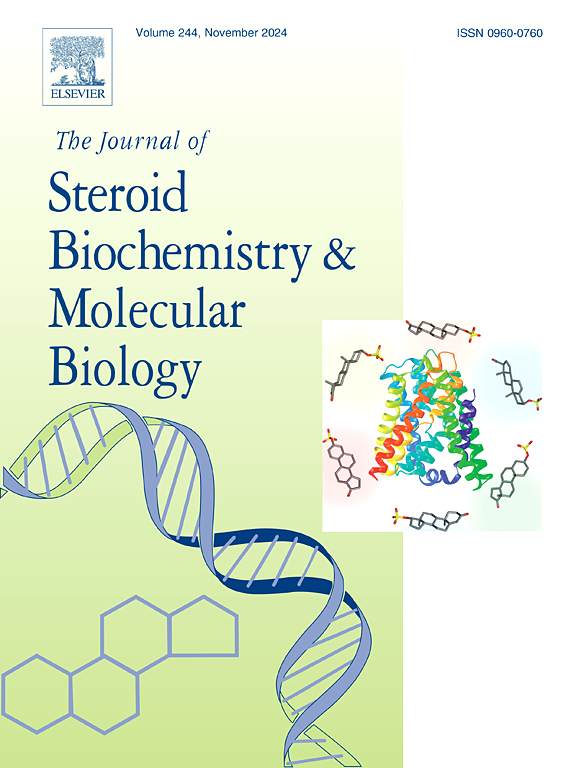Synthesis and preliminary evaluation of estradiol diselenocyanate derivatives as potential antitumor agents
IF 2.5
2区 生物学
Q3 BIOCHEMISTRY & MOLECULAR BIOLOGY
Journal of Steroid Biochemistry and Molecular Biology
Pub Date : 2025-05-04
DOI:10.1016/j.jsbmb.2025.106771
引用次数: 0
Abstract
Cancer is a prominent disease that poses a significant threat to human health, and the exploration of highly efficient and low-toxicity anticancer drugs remains an active area of research. Leveraging the cell-penetrating and binding capabilities of steroids, along with the multifunctional pharmacological properties of selenocyano groups, novel compounds are being designed and synthesized with the aim of discovering highly efficient and minimally toxic anti-tumor drugs. In the present study, two selenocyano pharmacophores were incorporated into estradiol to synthesize a series of estradiol diselenocyanate derivatives with a 3-selenocyanoalkoxy-17-selenocyanoester structure. The results of antiproliferative activities evaluation demonstrated that the estradiol derivatives with 3-selenocyanobutoxy moiety exhibited potent inhibitory activity against tumor cell proliferation, especially for triple negative breast cancer cell line MDA-MB-231. Their antiproliferative efficacy was significantly superior to that of estradiol analogues with 3-selenocyanooctyloxy and corresponding monoselenocyanate precursors, indicating a synergistic effect upon introduction of the second selenocyano group on cytotoxicity. The IC50 values for compound 4g against HeLa, HepG-2, and MCF-7 cells were determined as 3.20, 3.17, and 5.41 μM respectively; notably lower than those observed for its corresponding monoselenocyano precursor 3g which showed IC50 values of 15.12, 16.09, and 9.44 μM, respectively. Remarkably, the IC50 of compound 4e against MDA-MB-231 cells is only 5.04 μM and exhibited significant inhibitory activity against MDA-MB-231 zebrafish xenograft tumors. The inhibition of these compounds on tumor cell proliferation was attributed to induction of apoptosis in these cells. Thus, the estradiol diselenocyanate compounds investigated herein hold great potential as novel antitumor drugs, and warrant further investigation.
潜在抗肿瘤药物雌二醇二烯氰酸酯衍生物的合成及初步评价
癌症是严重威胁人类健康的突出疾病,探索高效低毒的抗癌药物一直是一个活跃的研究领域。利用类固醇的细胞穿透和结合能力,以及硒基的多功能药理特性,人们正在设计和合成新的化合物,以发现高效和最低毒性的抗肿瘤药物。本研究将两个硒代氰酸盐药效团掺入雌二醇中,合成了一系列具有3-硒代氰酸烷氧基-17-硒代氰酸酯结构的雌二醇二烯氰酸酯衍生物。抗增殖活性评价结果表明,含有3-硒氰丁氧基片段的雌二醇衍生物对肿瘤细胞增殖具有较强的抑制作用,特别是对三阴性乳腺癌细胞株MDA-MB-231的抑制作用。它们的抗增殖作用明显优于含有3-硒氰酸酯和相应的单硒氰酸酯前体的雌二醇类似物,表明在引入第二硒氰酸基团后对细胞毒性有协同作用。化合物4g对HeLa、HepG-2和MCF-7细胞的IC50值分别为3.20、3.17和5.41 μM;其IC50值分别为15.12、16.09和9.44 μM。值得注意的是,化合物4e对MDA-MB-231细胞的IC50仅为5.04 μM,对MDA-MB-231斑马鱼异种移植瘤具有明显的抑制活性。这些化合物对肿瘤细胞增殖的抑制作用归因于诱导肿瘤细胞凋亡。因此,本文所研究的雌二醇二烯氰酸酯化合物作为新型抗肿瘤药物具有很大的潜力,值得进一步研究。
本文章由计算机程序翻译,如有差异,请以英文原文为准。
求助全文
约1分钟内获得全文
求助全文
来源期刊
CiteScore
8.60
自引率
2.40%
发文量
113
审稿时长
46 days
期刊介绍:
The Journal of Steroid Biochemistry and Molecular Biology is devoted to new experimental and theoretical developments in areas related to steroids including vitamin D, lipids and their metabolomics. The Journal publishes a variety of contributions, including original articles, general and focused reviews, and rapid communications (brief articles of particular interest and clear novelty). Selected cutting-edge topics will be addressed in Special Issues managed by Guest Editors. Special Issues will contain both commissioned reviews and original research papers to provide comprehensive coverage of specific topics, and all submissions will undergo rigorous peer-review prior to publication.

 求助内容:
求助内容: 应助结果提醒方式:
应助结果提醒方式:


